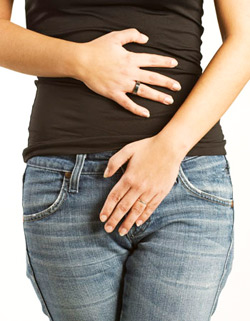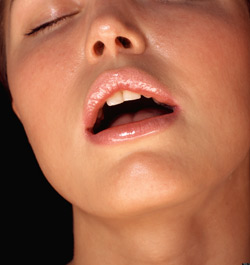|
|
Secrets of Female Sexual Arousal: A Complete Study
 Research suggests that cognitive factors like sexual motivation, perceived
gender role expectations, and sexual attitudes play important roles in women�s
self-reported levels of sexual arousal. In her alternative model of sexual
response, Basson suggests that women�s need for intimacy prompts them to engage
with sexual stimuli, which leads to an experience of sexual desire and
psychological sexual arousal. Psychological sexual arousal also has an effect on
physiological mechanisms; Goldey and van Anders showed that sexual cognitions
impact hormone levels in women, such that sexual thoughts result in a rapid
increase in testosterone in women who were not using hormonal contraception. In
terms of brain activation, researchers have suggested that amygdala responses
are not solely determined by level of self-reported sexual arousal; Hamann and
colleagues found that women self-reported higher sexual arousal than men, but
experienced lower levels of amygdala responses. Research suggests that cognitive factors like sexual motivation, perceived
gender role expectations, and sexual attitudes play important roles in women�s
self-reported levels of sexual arousal. In her alternative model of sexual
response, Basson suggests that women�s need for intimacy prompts them to engage
with sexual stimuli, which leads to an experience of sexual desire and
psychological sexual arousal. Psychological sexual arousal also has an effect on
physiological mechanisms; Goldey and van Anders showed that sexual cognitions
impact hormone levels in women, such that sexual thoughts result in a rapid
increase in testosterone in women who were not using hormonal contraception. In
terms of brain activation, researchers have suggested that amygdala responses
are not solely determined by level of self-reported sexual arousal; Hamann and
colleagues found that women self-reported higher sexual arousal than men, but
experienced lower levels of amygdala responses.
During the late 1950s and early 1960s, William H. Masters and Virginia E.
Johnson conducted many important studies into human sexuality. In 1966, they
released Human Sexual Response, detailing four stages of physiological changes
in humans during sexual stimulation: excitement, plateau, orgasm, and
resolution.
Singer's model of sexual arousal
Singer presented a model of the process of sexual arousal in 1984, in which she
conceptualized human sexual response to be composed of three independent but
generally sequential components. The first stage, aesthetic response, is an
emotional reaction to noticing an attractive face or figure. This emotional
reaction produces an increase in attention toward the object of attraction,
typically involving head and eye movements toward the attractive object. The
second stage, approach response, progresses from the first and involves bodily
movements towards the object. The final genital response stage recognizes that
with both attention and closer proximity, physical reactions result in genital
tumescence. Singer also stated that there is an array of other autonomic
responses, but acknowledges that the research literature suggests that the
genital response is the most reliable and convenient to measure in males.
Basson's sexual response cycle
In 2000, Rosemary Basson presented an alternative model to the human sexual
response cycle that is specific to women�s sexual response. She argues that
gender differences in sex drive, sexual motivation, sexual concordance, and
capacity for orgasm underlie the need for an alternative model of sexual
response. While the human sexual response cycle begins with desire, followed by
arousal, orgasm, and finally resolution, Basson�s alternative model is circular
and begins with women feeling a need for intimacy, which leads her to seek out
and be receptive to sexual stimuli; woman then feel sexual arousal, in addition
to sexual desire. The cycle results in an enhanced feeling of intimacy. Basson
emphasizes the idea that a lack of spontaneous desire should not be taken as an
indication of female sexual dysfunction; many women experience sexual arousal
and responsive desire simultaneously when they are engaged in sexual activity.
Toates's incentive-motivation model
Frederick Toates presented a model of sexual motivation, arousal, and behavior
in 2009 that combines the principles of incentive-motivation theory and
hierarchical control of behavior. The basic incentive-motivation model of sex
suggests that incentive cues in the environment invade the nervous system, which
results in sexual motivation. Positive sexual experiences enhance motivation,
while negative experiences reduce it. Motivation and behaviour are organized
hierarchically; each are controlled by a combination direct (external stimuli)
and indirect (internal cognitions) factors.
Excitation and inhibition of behavior act at various levels of this hierarchical
structure. For instance, an external stimulus may directly excite sexual arousal
and motivation below a conscious level of awareness, while an internal cognition
can elicit the same effects indirectly, through the conscious representation of
a sexual image. In the case of inhibition, sexual behavior can be active or
conscious (e.g., choosing not to have sex) or it can be passive or unconscious
(e.g., being unable to have sex due to fear). Toates emphasizes the importance
considering cognitive representations in addition to external stimuli; he
suggests that mental representations of incentives are interchangeable with
excitatory external stimuli for eliciting sexual arousal and motivation.
Various hypotheses and theories have been propounded in order to establish the
biological bases for sexual arousal in humans. Ivan Tarkhanov showed, in
experiments on cutting and artificial emptying of the seminal vesicles, that the
latter played the crucial role in the generation of sexual excitement in frogs.
Proceeding from these experimental results, Tarkhanov put forward a hypothesis
that filling and evacuation of the seminal vesicles were the main biological
cause which led to sexual arousal and its disappearance in mammals and humans.
Ever since Tarkhanov�s findings demonstrated sexual arousal in frogs to result
from the state of seminal vesicles, the attempted elucidation of their role in
other animals' sexual behaviour has been the object of experimental effort. No
generalisation has yet appeared, however. The study performed by Beach & Wilson
(University of California, Berkeley) in 1964 discovered that these glands do not
participate in the regulation of sexual arousal of male rats in the similar
manner. Whether the regularity observed in frogs is applicable to humans remains
unknown. Unambiguous experimental evidence for the existence of the Tarkhanov
regularity in human sexual behaviour has never been obtained.
Another explanation of sexual arousal is offered by the approach which Kazimierz
Imieliński calls the "psychohydraulic model of sexuality." This point of view
likens human sexuality to a steam boiler, with biological processes or internal
irritants creating sexual tension. If the level of this tension reaches
threshold, sexual arousal occurs as the expression of necessity to let off
steam. Gary F. Kelly (Clarkson University) describes this model as follows:
For centuries, the assumption was made that the longing for sexual interaction
was innate, and an inner drive model was used to explain it. It has been
suggested that this model was much like a metaphor for a steam boiler. Internal
sexual �steam� would build up until the pressure became so great that the drive
to release it was very strong. This view also assumed that there was some
adverse physical consequence of not releasing the pressure.
After a certain time, the same process begins anew. Such an approach assumes
sexual arousal to be a spontaneous desire that appears periodically like
sensations of hunger and thirst. Drawing a parallel between these sensations and
sexual excitation is widely accepted now: "Everyone must experience sexuality in
some way to survive. In this sense sex is a necessity of life, just as air,
food, and warmth.":190 And yet there is no empirical evidence in support of such
a parallel, Imieliński says. Sensations of hunger and thirst occur due to
certain states of physiological insufficiency. The feeling of hunger results
from the lack of glucose, fats and amino acids in blood. The feeling of thirst
occurs in response to reduction of the water content of tissues. None of similar
states of physiological deficiency responsible for the periodical appearance of
sexual arousal has been revealed in human sexuality.
 Sexual arousal in women is characterized by vasocongestion of the genital
tissues, including internal and external areas (e.g., vaginal walls, clitoris,
and labia). There are a variety of methods used to assess genital sexual arousal
in women. Vaginal photoplethysmography (VPG) can measure changes in vaginal
blood volume or phasic changes in vasocongestion associated with each heartbeat.
Clitoral photoplethysmography functions in a similar way to VPG, but measures
changes in clitoral blood volume, rather than vaginal vasocongestion.
Thermography provides a direct measure of genital sexual arousal by measuring
changes in temperature associated with increased blood flow to the external
genital tissues. Similarly, labial thermistor clips measure changes in
temperature associated with genital engorgement; this method directly measures
changes in temperature of the labia. More recently, laser doppler imaging (LDI)
has been used as a direct measure of genital sexual arousal in women. LDI
functions by measuring superficial changes in blood flow in the vulvar tissues. Sexual arousal in women is characterized by vasocongestion of the genital
tissues, including internal and external areas (e.g., vaginal walls, clitoris,
and labia). There are a variety of methods used to assess genital sexual arousal
in women. Vaginal photoplethysmography (VPG) can measure changes in vaginal
blood volume or phasic changes in vasocongestion associated with each heartbeat.
Clitoral photoplethysmography functions in a similar way to VPG, but measures
changes in clitoral blood volume, rather than vaginal vasocongestion.
Thermography provides a direct measure of genital sexual arousal by measuring
changes in temperature associated with increased blood flow to the external
genital tissues. Similarly, labial thermistor clips measure changes in
temperature associated with genital engorgement; this method directly measures
changes in temperature of the labia. More recently, laser doppler imaging (LDI)
has been used as a direct measure of genital sexual arousal in women. LDI
functions by measuring superficial changes in blood flow in the vulvar tissues.
Studies have found that women have a non-category-specific genital response
pattern of sexual arousal, meaning their genital responses are only modestly
related to their preferred category. On the other hand, female subjective
responses are category-specific, because they typically report their highest
level of arousal to their preferred stimulus, although the reported difference
in levels of arousal is typically much smaller than those in men. A possible
explanation for the non-category specific genital arousal in women, which also
accounts for their high individual variation, is the "preparation hypothesis".
This hypothesis suggests that, provided there is enough of an increase in
vaginal blood flow for vaginal lubrication to occur in a sexual context, the
magnitude of arousal need not be consistent. That is, the hypothesis is that
vaginal lubrication can take place as a protective mechanism even in a
non-preferred sexual situation, such as when sex is non-consensual.
Sexual arousal results in a combination of physiological and psychological
factors, like genital sexual response and subjective experience of sexual
arousal. The degree to which genital and subjective sexual response correspond
is termed concordance. Research has shown a reliable gender difference in
concordance of sexual arousal, such that men have a higher level of concordance
between genital and subjective sexual responding than women do.Some researchers
argue that this gender difference can be attributed to the type of method used
to assess genital responding in women. There may be a difference in women's
ability to perceive internal versus external genital engorgement subjectively,
as measured by vaginal photoplethysmography (VPG) and thermography respectively.
Chivers and colleagues found that men's and women's concordance was more similar
when thermography was used as a measure of genital sexual arousal than when VPG
was used. However, few studies using thermography have been conducted and
further research is required to determine whether the gender difference in
concordance is a measurement artifact or a true phenomenon.
Several hormones affect sexual arousal, including testosterone, cortisol, and
estradiol. However, the specific roles of these hormones are not clear.
Testosterone is the most commonly studied hormone involved with sexuality. It
plays a key role in sexual arousal in males, with strong effects on central
arousal mechanisms. The connection between testosterone and sexual arousal is
more complex in females. Research has found testosterone levels increase as a
result of sexual cognitions in females that do not use hormonal contraception.
Also, women who participate in polyandrous relationships have higher levels of
testosterone. However, it is unclear whether higher levels of testosterone cause
increased arousal and in turn multiple partners or whether sexual activity with
multiple partners cause the increase in testosterone. Inconsistent study results
point to the idea that while testosterone may play a role in the sexuality of
some women, its effects can be obscured by the co-existence of psychological or
affective factors in others.
Men and women experience sexual arousal very differently, not only
physiologically but psychologically, according to researchers who are studying
arousal using an array of new and refined methods.
Those methods are making it possible for researchers to understand the causes of
real-world problems, such as sexual dysfunction and high-risk sexual behavior
(see pages 54 and 58). But they are also giving researchers the means to explore
basic questions about the nature of sexual arousal and how its different
components--such as physiological arousal and subjective experience--are related
to each other.
"It's easier to get funding for research that focuses on, let's say,
AIDS-related sexual behaviors, than for research on the very fundamental
question of what sexual motivation and sexual arousal really are," says Erick
Janssen, PhD, a psychologist at the Kinsey Institute for Research in Sex, Gender
and Reproduction at Indiana University. "But in the long run, those basic
questions have to be answered before we can move on to explain other, related
behaviors."
Cognition and arousal
 One active area of research concerns cognitive factors that influence sexual
arousal. In the mid-1980s, Boston University psychologist David Barlow, PhD, and
his colleagues conducted a series of studies to examine the relationship between
anxiety and sexual arousal. They found that men with and without sexual problems
reacted very differently to anxiety-inducing threats of mild electric shock. One active area of research concerns cognitive factors that influence sexual
arousal. In the mid-1980s, Boston University psychologist David Barlow, PhD, and
his colleagues conducted a series of studies to examine the relationship between
anxiety and sexual arousal. They found that men with and without sexual problems
reacted very differently to anxiety-inducing threats of mild electric shock.
Men who reported having no trouble getting and maintaining erections, says
Barlow, "would believe that they were going to get shocked if they didn't get
aroused, so they would focus on the erotic scene." The result was that the
threat of shock actually increased sexual arousal. But men who had sexual
problems responded to the threat of shock very differently, says Barlow. "Their
attention would be so focused on the negative outcomes that they wouldn't be
able to process the erotic cues," he explains.
Next
Dated 09 June 2015
|
|
|
|
|









